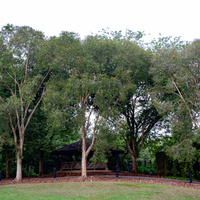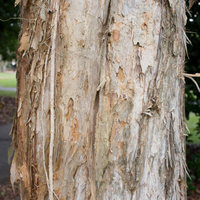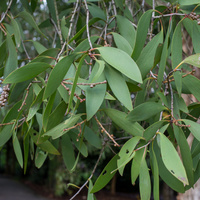Common name: Cajaput
Other common names: Cajeput, Cajuput, Paperbark tea tree, Swamp teatree
Description
Cajaput is an essential-oil yielding tree originating in Australia and Southeast Asia, its natural range extending from northern Australia, through Papua New Guinea, to Indonesia, Singapore, Malaysia, Thailand and Vietnam.
It may reach heights of up to 40 m (120 ft) with a trunk diameter of 1.2 m (4ft), though is more typically a medium-sized tree 10 to 20 m (30 to 60 ft) tall. The trunk is stout and supports a heavily branched crown, pyramidal when young, with age becoming rounded. The bark grey-white and peeling in papery sheets that persist in layers on the trunk.
Leaves are elongated oval, up to 10 cm long, tapered at both ends, leathery, dull green and etched with longitudinal lines running from the tip to the stem end. They are alternately arranged along the stems at the ends of the branches and remain on the tree throughout the year.
The flowers have long white filaments and are in dense clusters resembling bottle brushes. These bloom on and off throughout the year but are at their fullest around autumn and are followed by small, woody, cup-shaped seed capsules up to 0.4 cm (0.2 in) in diameter enclosing many tiny seed.
Use
The fresh leaves and young stems yield on steam distillation about 0.9 to 1% of a pale yellow essential oil traded as 'Cajeput oil'. It is mostly comprised of Cineole (also know as Eucalyptole), which is strongly antiseptic and the principal compound found in Eucalyptus oil.
Cajeput oil has a camphor-like odour and has long been used medicinally in its native range, internally as a treatment against coughs and colds and externally for relieving pain. This mirrors its use in western medicine as an antiseptic, principally against colds, sore throat, respiratory infections and laryngitis. Similar to Eucalyptus oil in its application, it is often steam inhaled. It is also useful against infections of the genito-urinary system and roundworms.
Applied externally it acts as a counterirritant, helping to stimulate circulation and because of this, is found as an active ingredient in branded ointments, gels and liniments.
Among the many everyday products containing Cajeput oil as an ingredient are toothpaste, lip balms, mouthwashes, gargles, throat lozenges, deodorants, shampoos, acne products, sunscreens, as well as dentistry and veterinary products. It is also commonly found used as a fragrance in soaps, lotions and perfumes, and used here, its camphor odour is very similar to 'Niaouli oil' from Broadleaf Paperbark (Melaleuca quinquenervia).
Cajeput oil in very small amounts is also used as a flavouring in non-alcoholic beverages, confectionery, frozen desserts, baked goods, condiments and relishes.
The trunk yields a medium-weight wood, in the 700 to 800 kgs per cubic meter (44 to 50 lbs per cubic ft) range, with good natural resistance to rot, decay and wood-boring insects, and is as well durable in contact with fresh and salt water.
The heartwood is pale brown and fine-grained. Well-formed logs, when available, are sawn into beams used for bridge and wharf construction, or into planks for flooring, furniture and cabinets, as well as boxes and crates. It also makes an excellent firewood.
The soft, papery bark has promise as a source for fibreboard, paper and packing material, and as a cork substitute in insulation. It can be easily torn off the tree by hand and has long been used as kindling for starting fires.
Honeybees are observed actively working the flowers but there does not appear to be much information on its value to honey production.
It is sometimes cultivated as a flowering ornamental and as a street tree in parts of its native range.
General interest
The name Cajaput is from the Malayan 'Caju puti' which means white tree, referring to the tree's grey-white bark.
Climate
Grows naturally in humid tropical lowland climates, generally in frost-free areas with annual lows of 19 to 25°C, annual highs of 29 to 35°C, annual rainfall of 900 to 4000 mm and a dry season of 5 months or less. It occurs on low, swampy coastal plains and where there is seasonal flooding, as well as in hilly terrain on dry, rocky and infertile soils.
Growing
New plants are usually started from seed and the seedlings tended in a nursery until the formation of the first flower buds, at around two years old, at which time they are planted out in the field. New plants can also be started from stem and branch cuttings.
Performs best on free- to slow-draining clay-loam, loam, sandy-loam and loamy-sand soils of an acid to neutral nature, generally with a pH of 4.5 to 7.0 and on sites with full to partial sun exposure. It has good tolerance to seasonal flooding, waterlogged soils, soil salt and strong wind conditions. Varieties coming from eastern Indonesia are reportedly adapted to growing in hilly inland areas on infertile, gravelly soil.
In commercial operations, harvesting starts at four years after transplanting and is usually mechanical, stripping the leaves and stems and cutting the plant back to about 1 m (3 ft) tall. Harvesting is then repeated at yearly intervals for about five years, after which replanting is done. Harvests of fresh leaves average 7,500 kgs per hectare, per year, and on steam distillation yield about 65 kgs of oil, the equivalent of 58 lbs per acre.
Problem features
Seed that falls to the ground is easily dispersed by flowing water and germinate readily. It can form dense stands, particularly in swampy areas or low-lying land subject to seasonal flooding.
The essential oil is poisonous if ingested in large amounts and should only be taken internally under medical supervision.
Where it grows
References
Books
-
Arctander, S. 1960, Perfume and flavor materials of natural origin, Elizabeth, New Jersey
-
Brady, G. S. & Clauser, H. R & Vaccari, J. A. 2002, Materials handbook : an encyclopedia for managers, technical professionals, purchasing and production managers, technicians and supervisors, 15th ed., McGraw-Hill, New York
-
C.A.B. International 2013, The CABI encyclopedia of forest trees, CABI Publishing, Wallingford, Oxfordshire
-
Chevallier, A. 2000, Encyclopedia of herbal medicine, 2nd American ed., Dorling Kindersley, New York
-
Cribb, A. B. & Cribb, J. W. 1982, Useful wild plants in Australia, William Collins, Sydney
-
Culbreth, D. M. R. 1927, A manual of materia medica and pharmacology : comprising the organic and inorganic drugs which are or have been recognized by the United States pharmacopeia, 7th ed., Febiger, Philadelphia
-
Do, D. S. & Nguyen, H. N. 2003, Use of indigenous tree species in reforestation in Vietnam, Agricultural Publishing House, Hanoi
-
Doran, J. C & Turnbull, J. W. 1997, Australian trees and shrubs : species for land rehabilitation and farm planting in the tropics, 2nd ed, Australian Centre for International Agricultural Research (ACIAR), Canberra, Australian Capital Territory
-
Groom, N. 1997, The new perfume handbook, 2nd ed., Blackie Academic & Professional, London
-
Jelks, Mary 1986, Allergy plants : that cause sneezing and wheezing, 1st ed., World-Wide Publications, Tampa, Florida
-
Khan, I. A. & Abourashed, E. A. 2010, Leung's encyclopedia of common natural ingredients : used in food, drugs and cosmetics, 3rd edition, Wiley Publishing, Hoboken, New Jersey
-
Macmillan, H. F. 1943, Tropical planting and gardening : with special reference to Ceylon, 5th ed, Macmillan Publishing, London
-
National Research Council (Board on Science and Technology for International Development) 1983, Firewood crops : shrub and tree species for energy production (Volume 2), The National Academies Press, Washington D. C.
-
Oyen, L. P. A. & Nguyen X. D. 1999, Plant Resources of South-East Asia (PROSEA) 19 : Essential-oil plants, Backhuys Publishers, Leiden
-
Randall, R. P. 2002, A global compendium of weeds, R.G. and F.J. Richardson Press, Melbourne
-
Streets, R. J. & Troup, R. S. 1962, Exotic forest trees in the British Commonwealth, Oxford University Press, Oxford, England
-
Weiss, E. A. 1997, Essential oil crops, CABI Publishing, Wallingford, Oxfordshire
-
Winter, R. 2009, A consumer's dictionary of cosmetic ingredients : complete information about the harmful and desirable ingredients found in cosmetics and cosmeceuticals, 7th ed, Three Rivers Press, New York




